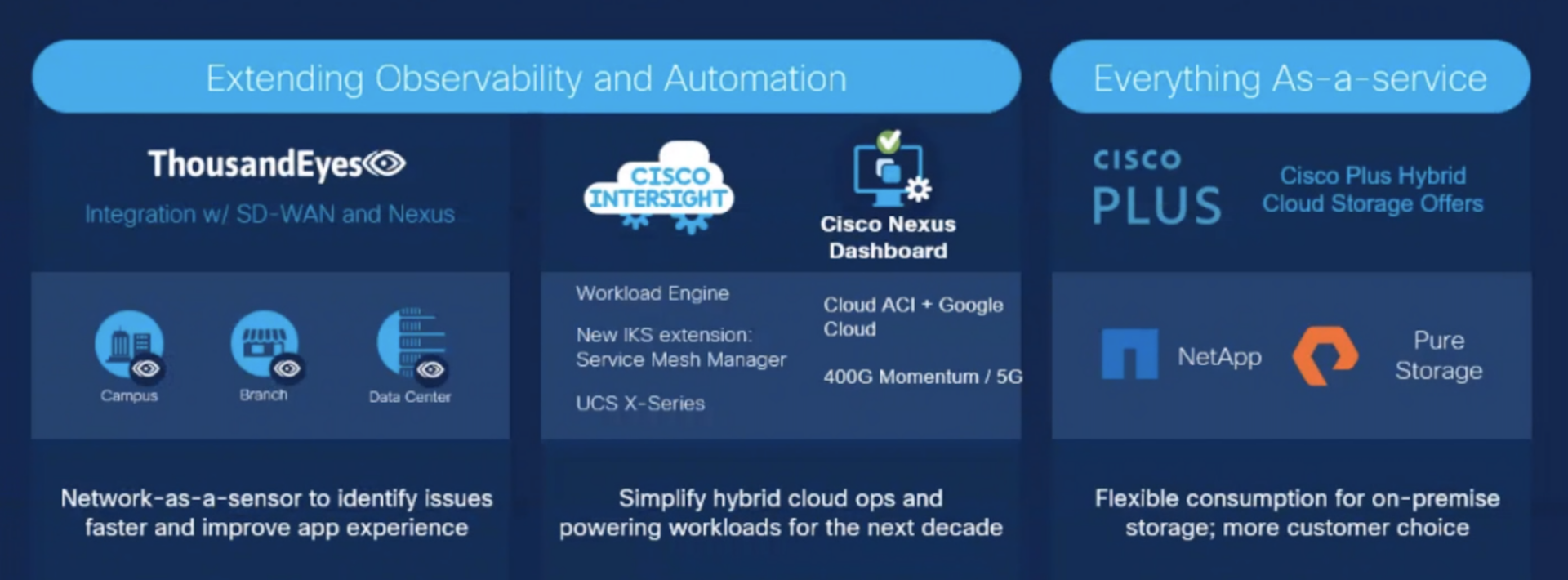June is proving to be a busy month in the tech world. Cisco is no exception and has announced a new launch within their portfolio. I had the opportunity to attend Cisco’s Future Cloud event, and I am providing my summary of Cisco’s future direction. They focused on innovation in these main areas:
- Extending observability and automation
- Everything as-a-service
- Accelerating hybrid cloud operations

These focus areas include a number of announcements such as:
- ThousandEyes integration with SD-WAN and Nexus
- Advancements with the Cisco UCS X-Series
- Cisco Intersight’s portfolio of services that enable intelligent visualization, optimization, and orchestration that promise to bring your teams, tools, infrastructure, and apps together and simplify hybrid cloud ops and powering workloads for the next decade
- Cisco Plus defining flexible as-a-service consumption for on-premises storage
Extending Observability and Automation – What’s New with X-Series
This latest Cisco announcement has a lot to unpack. In this blog, I am focusing on Cisco Data Center Network Insights and the latest advancements in the Cisco UCS X-series offering. With this launch, Cisco continues to drive change, building on HCI, containers, accelerating compute and expanding on new technology to drive its Unified Computing System (UCS) platform. This includes driving towards the future with a subscription or consumption model.
In addition to the consumption model for the X-series switches, Cisco is also aligning HCI, flash, and scale to a consumption model. This approach supports the recent ESG research study I shared in an earlier blog in which 48% of IT leaders say their organizations would prefer to purchase on-premises data center infrastructure through a consumption-based model. This consumption model is embedded into Cisco’s “hybrid everything” approach for the next decade, which is about delivering hybrid clouds, hybrid apps, and hybrid consumption and operation models.
In a hybrid world, complexity is the data center Achilles’ heel. Cisco seeks to solve complexity, cost-effectiveness, and rigidity within traditional data center infrastructures with this most recent launch. And the future introduces a number of new ecosystem innovations that are adding to the complexity challenges. Cisco introduces a modern hybrid cloud infrastructure that promises simplicity–simple to operate, to scale, and to evolve.
X-Series Features and Benefits
The Cisco UCS X-Series powered by Intersight simplifies the infrastructure by providing scalable operations, common services, unified open fabrics, and an adaptable infrastructure built on top of the new X-fabric delivering solutions for both public and private clouds. This infrastructure also supports hybrid cloud operating models and provides frictionless, faster time to application deployments. This release improves flexibility and is built to provide adaptability that will help customers be ready for the next generation of challenges such as growth and frictionless deployments for new initiatives.
The Cisco UCS X-Series provides a number of new features to expand on Intersights adaptability. Some of these advancements include an evolve-as-you-go backplane, unified fabric managed by Intersights, low latency traffic with CXL, and PCIe and memory / drive nodes.
The Cisco UCS fabric provides an open, modular design that easily adjusts resources to adapt for applications. The UCS fabric runs modern apps by assembling modules into systems. UCS X-Series with Intersights provides a simplified, single platform for most applications such as AI/ML, VDI, and big data sources and types. The X-Series offerings also expand supported workloads.
Cisco’s UCS X-Series use cases are widened with this launch to include not only mission-critical enterprise applications like Oracle, SQL, and SAP but also general purpose, new application, and dense storage use cases such as HCI, big data, AI/ML, and archival.
The X-Series combined with Intersight provides an adaptable infrastructure to drive high-performance workloads while also providing the foundation for hybrid clouds, including Intersight services on:
- Infrastructure
- Workload Optimization
- Kubernetes Services
- Terraform Services
This adaptable infrastructure is combined together with the simplicity of transforming converged infrastructure.
What’s Next for Cisco X-Series
Cisco promises a number of new enhancements with this launch for the X-Series. The focus is centered around simplicity, flexibility, and providing a future-ready solution for their customers.
- Simplicity is targeted at a cloud managed without rigid hardware configuration rules. This is done by providing 36% fewer components.
- Flexibility focuses on a modular system with blade and rack functionality. This also adds 30% larger compute nodes with improvements on power and cooling.
- Future-ready is designed to focus on what’s coming next for the platform. This includes a cloud-operated infrastructure with a simple system design for both traditional and modern applications.
According to Cisco, the future and target of 2030 and beyond is to institute fabric-ready, silicon photonics and liquid-cooling—which will be done in this product scenario by leveraging Cisco Intersight to manage the UCS X-Series.
In this launch, Cisco also introduces the Hyperflex 5 providing data center core, hybrid cloud, and edge deployments. Included with this release are enhancements to data-at-rest encryption, Intersight workload and Kubernetes services, and N:1 disaster recovery.

If you want to learn more, check out a related post by my colleague, Bob Laliberte, covering ThousandEyes and networking-as-a-sensor, identifying and improving application experiences.
Summary
Cisco is providing a lot of innovation with this overall portfolio release. The technology is designed to address business challenges and deliver what the customer base is asking for. Cisco has an ambitious approach across the portfolio, which is making this a big launch. Its success will depend on how Cisco executes and how they manage the go-to-market strategy to get the new messaging out. It will be exciting to see how customer and the industry overall responds to these advancements in the Cisco portfolio.







